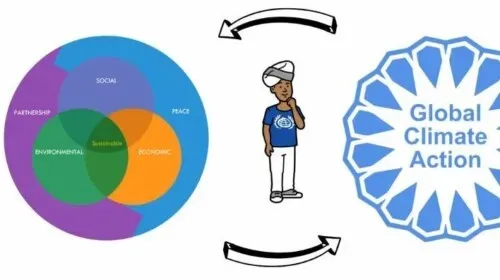Global Climate Action is more than a catchphrase; it is a framework that aligns policy, technology, and economic growth with the planetary boundaries we share, and invites cross-border collaboration. As nations, cities, and businesses commit to ambitious climate goals, the conversation shifts from isolated measures to integrated strategies that blend climate policy with practical action, underpinned by joint research, finance, and policy alignment that reduces barriers and accelerates pilots in cities and regions around the world. This opening look shows how advances in green technology and a focus on sustainable growth can drive meaningful progress, reduce emissions, and build resilient economies that can withstand energy-price volatility and supply-chain shocks. By weaving together climate policy, decarbonization efforts, and renewable energy adoption, we can unlock scalable solutions that benefit people, industries, and ecosystems alike, from households lowering bills to manufacturers upgrading infrastructure. Together, these elements set the stage for a transformative low-carbon transition that supports prosperity and planetary health, while empowering communities to participate in the benefits of a cleaner, more reliable energy system.
From an alternative-terms perspective, the conversation resembles environmental governance and a deliberate energy transition guided by carbon pricing, resilience planning, and clean-energy incentives. This lens highlights low-carbon pathways, decarbonization strategies, and renewed investment in renewable energy adoption as core levers for progress. In line with Latent Semantic Indexing principles, related terms such as the green economy, climate resilience, energy efficiency, and sustainable development broaden the scope beyond emissions. Framing the topic in these related concepts helps audiences connect policy design, technology deployment, and growth outcomes in a single, coherent narrative. Together with the first paragraph, this broader framing creates a richer picture of what Global Climate Action means in practice.
Global Climate Action: Policy Design, Decarbonization, and Renewable Energy Adoption
Global Climate Action is more than a slogan; it is a framework that aligns climate policy, market incentives, and economic growth with planetary boundaries we share. Effective climate policy design uses carbon pricing or emissions trading, performance standards for power and transport, and subsidies that accelerate renewable energy adoption and other green technology, while supporting research and deployment of new technologies. When designed with equity in mind, policy becomes a catalyst for decarbonization and sustainable growth, directing investment toward solutions that benefit people, industries, and ecosystems alike.
Policy also shapes resilience and long-term competitiveness: climate risk disclosure requirements, building codes that prioritize energy efficiency, and infrastructure investments that withstand extreme weather. International cooperation and aligned standards help countries scale up clean energy projects, accelerate renewable energy adoption, and spur the deployment of green technology across industries. Shared funding mechanisms reduce the cost of capital for decarbonization efforts. In this sense, Global Climate Action relies on a policy framework that is predictable, transparent, and adaptive to science and market conditions, guiding sustainable growth across sectors and regions.
Green Technology Deployment and Financing Pathways for Sustainable Growth within Global Climate Action
Green technology is the engine of climate progress. From solar photovoltaics and wind turbines to advanced energy storage, grid modernization, and low-emission fuels, green technology reduces costs and improves the reliability of clean energy. Breakthroughs in batteries, hydrogen, and power electronics diversify the energy mix and support decarbonization across transport, heavy industry, and power systems. Digital tools, AI, and data analytics further enable renewable energy adoption by optimizing usage, matching supply with demand, and cutting waste, helping economies run more efficiently without sacrificing reliability.
Financing the transition is equally critical. Public funding for research and deployment must be complemented by private capital, with blended finance, green bonds, and performance-based incentives accelerating decarbonization and renewable energy adoption at scale. Transparent project pipelines, risk-sharing mechanisms, and strong governance increase investor confidence and reduce the cost of capital for climate-ready infrastructure. When climate policy signals align with market incentives, funding flows support sustainable growth, create resilient jobs, and broaden access to clean energy across communities.
Frequently Asked Questions
How does Global Climate Action leverage climate policy, green technology, and renewable energy adoption to accelerate decarbonization?
Global Climate Action is a framework that coordinates climate policy, green technology, and renewable energy adoption to accelerate decarbonization and build resilient economies. It uses policy instruments—carbon pricing, performance standards, and subsidies—to spur investment in clean power and energy storage. By aligning policy with advances in green technology and finance, it lowers emissions while creating good jobs in low-carbon sectors. When governments, cities, and businesses work together, scalable clean energy projects improve reliability and support a just transition.
What role do sustainable growth and green technology play in Global Climate Action, and how can nations balance growth with decarbonization?
In Global Climate Action, sustainable growth comes from integrating green technology with economic development. Green technology lowers energy costs, boosts productivity, and drives decarbonization while expanding opportunities in the clean economy. Climate policy and smart financing steer investment toward energy efficiency, renewable energy adoption, and resilient infrastructure. To balance growth with decarbonization, policies must ensure equitable access to clean energy, retraining for workers, and transparent governance.
| Aspect | Key Points |
|---|---|
| Policy Foundations of Global Climate Action |
|
| Policy for Resilience & International Cooperation |
|
| Technological Innovations Driving Action |
|
| Digital Tools and Data Analytics |
|
| Sustainable Growth & Decarbonization |
|
| Financing Global Climate Action |
|
| Global Cooperation and Equity |
|
| Case for Action: Integrating Policy, Tech, and Growth |
|
Summary
Global Climate Action is a collective journey that demands coordinated effort across government, industry, and civil society. By grounding policy in transparent rules, accelerating green technology deployment, and pursuing sustainable growth that benefits all segments of society, we can accelerate the transition to a low-emission economy while creating resilience and opportunity. The path is challenging, but the rewards—cleaner air, healthier communities, robust economies, and a planet that remains hospitable for current and future generations—are profound. Embracing policy, technology, and sustainable growth as interdependent pillars will unlock the scale of change necessary to meet our shared climate commitments.

